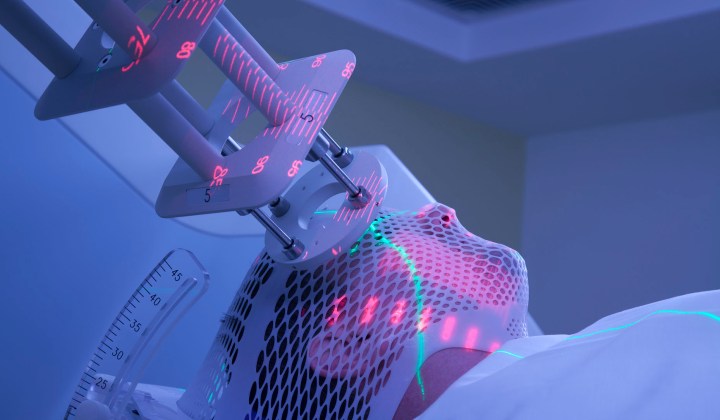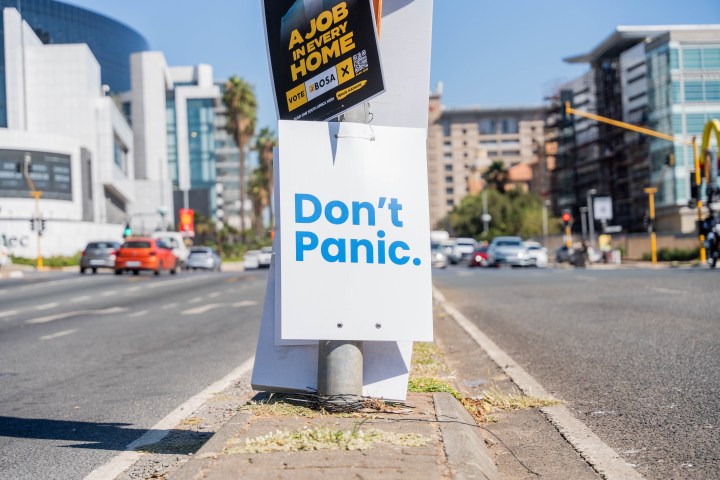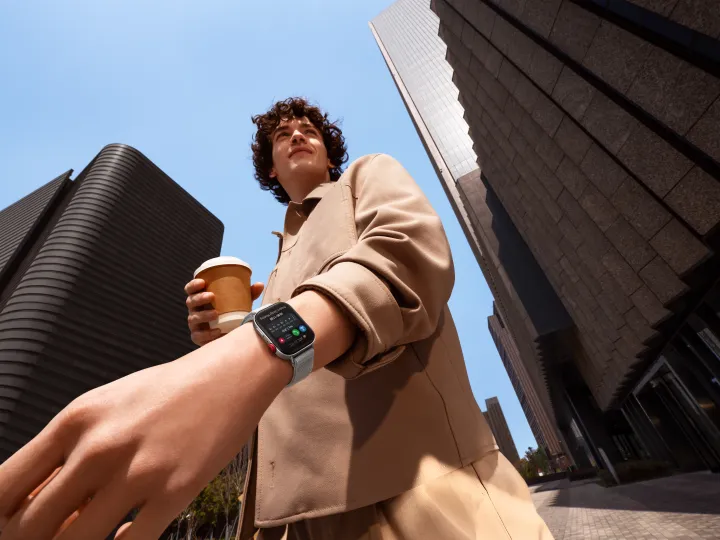A PERSONAL REFLECTION
Beating the ‘Big C’ with a radioactive isotope flown into SA from Finland

The writer has just undergone a new cancer treatment, and the process encourages him to think about the cost and management implications of such treatments under the proposed National Health Insurance.
Back when we thought the world was young, we puzzled over the deeper meanings of TS Eliot’s The Love Song of J Alfred Prufrock and his agonies and anxieties about ageing, mortality and death. None of us who read the work at that age believed we too were vulnerable to the ravages of old age.
As high school or university students, we were poised to begin careers or revolutions (or maybe both) — and many other adventures. For all practical purposes, we believed we were invulnerable. Revolutions are created by the young and innovations in the economy and business are usually the property of the young. Despite years of fighting, Odysseus was not yet a cranky old man and at least young at heart. We were ready, too.
But none of us are immune to ageing. Eventually, we will puzzle, like Prufrock, over whether we should eat a peach, wear the bottoms of our trousers rolled, or all the rest of Eliot’s melancholic inventory of frustrating challenges.
Last year, I slipped on a patch of gravel while I was taking a Sunday walk, and needed to wear one of those moon boots while a broken leg bone slowly knitted itself back together. I already carried out a daily routine of blood tests after discovering I had type 2 diabetes. My eyes needed cataract surgeries and yet other procedures. “And so it goes; and so it goes,” just as Kurt Vonnegut had promised — or threatened.
Then the “Big C,” cancer, came a-calling as well. The longer one lives — and in the rich world, men usually hang on until their late seventies and women even longer — the more likely a run-in with it is. It is no longer a mysterious thing to be whispered about in the shadows. The body’s cells, or at least some of them, go into revolt and begin their disorderly, accelerated growth trajectories. They multiply rapidly, increasingly monopolising the body’s bloodstream; this spreads to other organs. Eventually, the cancer draws increasing amounts of the blood’s nutrition and oxygen away from the better-behaved cells and tissues.
Precisely how or why this happens to some cells and not others is not fully understood yet, but medical research points, in many cases, to external influences like carcinogenic chemicals or tobacco smoke, viruses, noxious food additives, prolonged exposure to the sun’s rays, and even gamma rays from outer space. Those all may be triggers.
What seems to happen is these influences (or perhaps an inherent characteristic of some cells) generate changes — mutations — in the genetic material of the body’s cells. Some of those mutations do not matter very much, as between red hair and brown, but others can generate cellular tissues that begin runaway, disorderly growth — the very opposite of the structured growth of normal tissue. (Of course, mutation is not an entirely bad thing — without it, there would be no evolution and we would still be unicellular amoebae.)
Over the years, members of my family — like most families these days — have had encounters with cancer. Treatment has included surgery, chemotherapy and radiation — separately or in combination. For many, surgery can be dramatic, requiring significant recovery periods. Chemotherapy can create side effects like hair loss and strange taste and olfactory sensations. Radiation may lead to immense tiredness, among other side effects.
But, as the years have passed, these treatments have become increasingly refined, especially surgical interventions that feature lead and reconstructive surgeons operating in tandem, minimising multiple interventions. Chemotherapy treatments increasingly rely upon newly developed drugs precisely targeting the specific form of cancer being treated, and radiation uses equipment operating at near nano-levels of intervention to knock out the cancer cells and tissue.
While they are not yet available, researchers are heading towards chemotherapy that will work directly on the tumours at the specific genetic level of a patient’s tissues and cells. Some of those treatments are only a few years away from being clinically tested.
Rodent ulcers
Inevitably, it was my turn for a run-in with cancer. A decade ago, I observed unusual lumps on my face. Our dermatologist — yes, every light-skinned person living in Africa needs to make friends with one, in addition to making copious purchases of sunblock and wearing a sturdy well-brimmed hat — explained that the colloquial name for these nasty things was “rodent ulcers”.
Rodent ulcers, hmmm. The big question was whether they were dangerous, or just an inevitable part of ageing, like needing an afternoon nap. He explained that the more scientific description was “basal cell cancer”. (There are also squamous cell cancers and the really, seriously bad guy, the melanoma.)
These basal cell cancers can and should be removed, but that should not be a serious thing if they are caught early and dealt with decisively. Appropriately means cauterising, freezing or surgically removing them — depending on their size and depth from the skin’s surface. That first time, the decision was to go the surgical route, given the size and apparently aggressive growth of those bad boys on my cheek, the bridge of my nose, and a spot adjacent to my nose.
As a result, I had an appointment at a day surgery clinic in Pretoria where a specialist reconstructive surgeon held court. I was kept semi-conscious throughout the surgery and could see something of what was happening, but felt nothing during the entire procedure, thankfully.
This particular surgical exercise is called Mohs surgery after its originator, an early 20th-century Austrian surgeon. The bad guys are cut out, and depending on how accessible and pliable it is, a skin flap from one’s cheek is drawn across and stitched together with the tissue at the side of the nose.
There isn’t much tissue in that space to work with, so the idea behind the surgery is to appropriate neighbouring tissue to seal up the incision — after the rodent ulcers are removed. Along the way, one’s nose is pulled slightly towards one side, although in the healing process the underlying nasal cartilage eventually moves back, closer to its original place, so one barely notices the surgery and the scar is virtually invisible.
In my case, the end result had a faint echo of a boxer’s facial physiognomy, with a bit of a lopsided look as a result of one boxing match too many. Still, according to some observers, it had a slightly rakish aura now that symmetry had been tweaked.
One startling moment happened as I was recovering from the effects of the surgery and anaesthetic drugs. The surgeon came back into the recovery room — presumably to admire his tidy handiwork — and asked me if I was the same person as that Brooks Spector fellow who wrote for Daily Maverick. My surgeon said he was an ardent reader and admirer of the publication. “Yes,” I confessed, I was that very person, but, sadly, I was insufficiently coherent to be able to discuss any of my writings or his views.
The rodents return
After the removal of the stitches and periodic follow-up examinations, I was pronounced cleared. Good to go. Things went along that way for years. Just the normal bumps and scrapes of everyday life, facially speaking. But a month or so ago, while shaving, I noticed new outcroppings that seemed very similar to the previous ones — and near where the surgery had been performed. Off to the dermatologist I went, months ahead of my usual appointment.
Bad news. The rodents were back, stronger than ever. Another round of Mohs surgery was an option, but the doctor suggested a radiation approach instead. There was a new treatment, now clinically tested and approved in Europe, the UK, the US, South Africa and elsewhere, that used an isotope of the rare-earth element rhenium, an element that was only identified and isolated in 1925.
There were some complications. The dermatologist was not a specialist in dealing with rhenium, although he could make the appropriate referral for me. But the arrangements seemed tricky. While rhenium is found in South Africa as part of a complex of other metallic ores like molybdenum, it is not being separated from that ore, let alone worked with here to isolate the radioactive form used in this procedure.
Adding to the complexity, this isotope’s half-life (the time it takes for half of the volume of the radioactive isotope to emit the radiation that turns it into a stable, non-radioactive form or another stable element as a result of it emitting subatomic beta particles) is less than a day. That put the entire treatment schedule on a very short, precise timeline. Using a stable, non-radioactive rhenium is useless.
Further, the plant separating the isotope from the stable rhenium is in Finland from where it is rushed to clients elsewhere, like those of us in South Africa. That involves urgently sending it to Munich and then on a direct flight to Johannesburg’s OR Tambo airport. After being unloaded, it is driven to the treatment centre. Any delays in connecting flights, customs confusions, or a massive traffic jam on the highway from the airport to the clinic would, soon enough, render my rhenium (I was already thinking of it as my rhenium) to a very expensive, but near-inert blob.
The doctor’s fees are reasonable, considering all the time the process takes, but the shipment of the rhenium and the material itself was close to the cost of a well-used but serviceable compact car. It is more expensive than the surgery would have been, that’s for sure.
So, on the appointed day and hour, the radiation specialist doctor had three of us patients lined up for treatment at the same time, as soon as the nuclear physics specialist drove up to the door bearing his big, lead-lined box. Fortunately, we were right on schedule — even without a blue-light special escort.
The three of us were already seated and with the plastic, translucent foil already in place that would hold the rhenium on the parts of our bodies to be irradiated. The team took the small rhenium vial out of its container and inserted it into equipment that would dispense the material in accordance with the treatment protocols after they had made last-minute adjustments to the computerised calculations of just how much, how thickly, and how widely it would be applied on our bodies.
Just sit tight
In my case, that plastic foil was stuck to my cheek and nose with the margins (the area within which the cancer has spread but no further, so far) drawn upon it. Then the special applicator — something like a strange toothpaste spreader or a cake frosting applicator married to hi-tech commercial kitchen gear — dispensed the rhenium on to my face in accord with the calculations made by the specialist team. I was told not to move, wiggle, smile, laugh, talk or anything else that might crack the goo and cause it to fall off and into my mouth. If that happened, it could be ingested with unknown but baleful consequences. Just sit tight for the next several hours.
There was a contradiction in all of this — the clinic didn’t want us to go hungry during our treatment so they had a sandwich, fruit, cheese and crackers tray placed in front of us, but with the stern admonition ringing in our ears. Five hours later, the doctor removed the plastic film with the rhenium on it, placed that in another lead container, and we were good to go.
We were advised that with just a little bit of luck, this would be a one-shot treatment as the beta rays from our newfound friend, the rhenium paste, penetrate the upper layers of our skin and destroy those bad boys lurking in there, even as they allow good tissue to escape death and eventually regenerate.
There would be a bright red splotch on the affected areas and it would start to scab over as healing began. We would have a face for radio, as broadcasters might say. The healing should be finished in a couple of months, at worst. But, by all means, stay out of the sun, wear a hat, use sunblock, ph-neutral soap and good skin cream to keep the area moist, and come back for further checking in two months.
Given the cost of this treatment at a private clinic, do public hospitals make it available to their patients? It turns out they do, although the queue can be daunting. My specialist does some of her practice in public hospitals as well. But the big drawback is the cost of the rhenium itself — if the current supply chain complexity remains in place.
Just coincidentally, in a conversation I happened to have with a part-time pharmacist at my usual pharmacy, I learned she also works at Pelindaba, the research reactor facility (yes, the facility involved in South Africa’s old nuclear weapons project decades ago) that has continued to refine and produce isotopes of molybdenum for medical use in South Africa. She explained that they have plans to produce rhenium isotopes in the next few years for treatments like the one I had.
If that were the case, the rhenium supply chain would no longer be jeopardised by airport traffic jams or screw-ups with customs freight clearance. Moreover, local production will drive down the cost of treatment with this isotope, making it accessible to many more people. Indeed, such challenges and outcomes should be studied carefully as part of the much larger debate over access, management and funding of the promised new National Health Insurance.
Meanwhile, I watch for signs of regenerating, healthy tissue — and always wear a hat, use sunblock, and stay out of the sun, just in case. DM















Wishing you all the best, and I am positive your treatment will be a success!
Very best wishes for your your recovery, Mr Spector, and thank you for your always thoughtful and very interesting and informative articles.
I wish you well in your recovery, Brooks!
I’ve dealt with those nasty buggers as well, over the years. Thanks for informing the public of the dangers that lurk outside as well as the brilliant possibilities provided my modern medics and science!
So sorry to hear about your recent health scare, but great to learn about your professional journey and success.
I wish you continued good health and happiness!
Check Baz Luhrmann and his sunscreen……. Good luck…